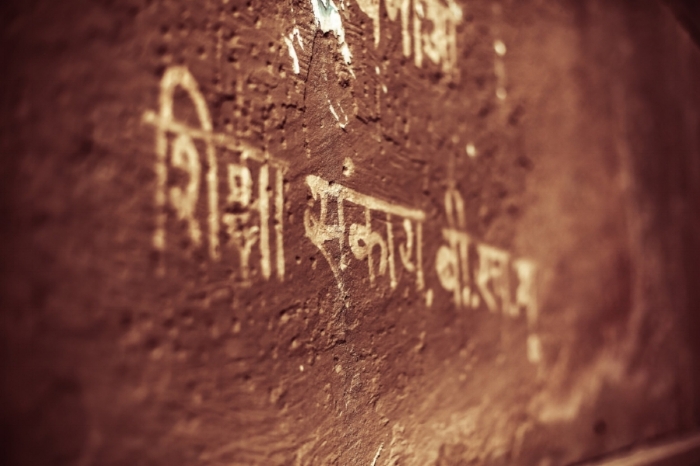
The word mantra comes from the Sanskrit language and can be broken down into two parts: “man,” which means mind, and “tra,” which means transport or vehicle. One could interpret this as an instrument or vehicle that helps transport or elevate the mind. Many experience mantra as a way to retreat from the regular mind and to deepen the faculties of intuition, spiritual strength, and happiness.

Mantras are sound vibrations that help to shape our reality. According to Sanskrit scholar, Thomas – Ashley Farrand, “Mantras are energy-based sounds that create thought energy waves.”
Every sound of the Sanskrit alphabet corresponds to our chakra system. The chakra system is the main conductor for electromagnetic currents in the human body and the channels that run through this system are called nadis. According to many Tantric texts, the human body contains 72,000 nadis that channel prana (our life force energy) to every cell of our being.
The seven primary chakras run along the spinal column from the base of the spine to the crown of the head, each one responsible for governing the health and pranic flow of different stages of our consciousness. The chakra system corresponds to the emotional body, not the physical body, and each chakra is situated at a plexus of nerves in the physical body.
Imagine the chakras as flowers stacked along the spine. Each sound of the Sanskrit alphabet corresponds to a particular petal on a specific (chakra) flower. Every time we chant that particular mantra or sound we water that specific flower.
Just as water nourishes the plants in a garden, so mantras nourishes all that is beneficial for our lives. Each time we chant, we plant seeds for transformation and tend to the garden of our being. Eventually, the garden begins to bear fruits in the form of abundance, love, compassion, healing or that which lifts us to an elevated state of consciousness. The benefits of this practice can radiate outward and be a fruitful offering for someone else such as a friend, family member, neighbor or even the planet! Mantras help us restore the health of our inner garden and bear witness to the colors of life blooming all around us.



The great yoga scriptures recommend the student to receive initiation into mantra directly from a spiritual master. Someone who you feel is your guru or master will not only give you the mantra you truly need but can also transmit energy for a deeper spiritual experience and awakening. However, in Thomas Ashley Farrands book, Healing Mantras, he speaks to the process of humbly and whole-heartedly working with mantras without having received full initiation from a guru. The key here is intention. Whether you seek to work with mantras on your own or to receive one from a spiritual teacher you will want to have a clear intention for why and how you wish to utilize this sacred practice. Yoga International writes, “A good student cannot end up with a bad teacher. To determine if you’ve found the right path, the right tradition, and the right teacher, ask yourself how spontaneously and effortlessly you are drawn in that direction. Observe carefully what is reflecting in your mind and listen attentively to what is echoing in your heart.”
Sadhana is often interpreted as “daily spiritual practice” as well as, “a means of accomplishing something”. It is also seen through many traditions as a way of life. Sadhanas are practices that help us to live more mindfully by integrating our spiritual life and our “normal every day experiences” thus creating a lifestyle filled with meaning, connection and well-being.
If you are initiated into a mantra your teacher will give you specific instructions for how to carry out that practice. If you choose to go the route of exploring mantra on your own here are a few points to consider for setting up your sadhana for success!
Is your mantra meant to be chanted the rest of your life?
Are you chanting once or twice a day?

Set up a space dedicated to mantra
Make sure there are no interruptions (cell phone, children, etc.)
Consider creating an altar to help maintain the consistency of your practice. Altars can act as powerful reminders to practice. It’s like stepping into a dedicated office space for your job.
Begin with a planetary aspect such as the new or full moon. These energies can help to deepen the seeds of commitment needed to sustain your sadhana.
Is your mantra related to a planet or zodiac sign? Consider the relationship to better attune to the planetary energies that will help your sadhanas bear fruits.



Here are some of the main benefits you will receive by developing a daily mantra practice:
When we finally sit down to meditate we begin to witness the complex nature of our mind and how far off track it can actually take us. The mind is so powerful it can evoke feelings and emotions not really happening in the present moment. This point is illustrated for us when we suddenly get angry with someone for what they did to us years ago just by reimagining it. Even if the wound has healed the memory and thoughts alone can bring up a great deal of feeling. Feelings lead to thoughts, more feelings and more thoughts. The same goes for when we are fantasizing about a weekend getaway with friends that might not even take place in the future. Our minds are spinning and we are suddenly transported into that moment. The mind pulls us back and pushes us forward, constantly. Through mantra meditation, we learn to take the reins of the wild stallion that is the mind and begin to steer it into the present moment.
We humans have a high threshold for pain. We also have an incredible capacity for carrying around stuff that doesn’t belong to us like anger, remorse, jealousy, etc. Mantra meditation creates a safe way into a higher perspective of our own thinking where we can then decide, “do I want to be angry?,” “is this jealousy serving me?,” and so forth.
Mantra meditation helps to alleviate stress because it simplifies things, A LOT. Let’s say for instance you work in an environment where stress is the norm, meeting deadlines and pleasing people with your work. The thing to check in about is whether or not you really have to bring that same energy that works so well in the office into your home life. Having a mantra meditation practice can help you discern where and when to put your stress into action and when and where to let it go.
If something happens in life and there is no real resolution other than, say, time, mantra meditation can help you to accept the reality for what it is, in the present moment. What’s the sense in being so stressed out over a situation if the stress itself isn’t helpful? If stress isn’t leading you to a solution and only keeps your body tense and your mind darkened in negative thoughts, it’s time for you to develop a mantra meditation practice.
The Nervous System is one of the most vital systems in the human body. It’s made up of many parts. One of these is the ‘sympathetic nervous system’ which is responsible for the ‘Fight or Flight’ reaction. There are not too many daily scenarios where we should exist in the intensity of “fight or flight” yet, because of stress and uncontrollable thoughts, many of us do. The parasympathetic nervous system is responsible for the so-called ‘Rest and Digest’ functions. When we meditate we encourage our bodies to do just that. Rest and digest, bringing balance and health into our bodies and minds.
How we care for ourselves is everything. Yes, we want to be excellent and ahead of the curve in all that we do AND this includes taking care of ourselves in a way that truly supports this go-getter attitude. Setting boundaries can be incredibly difficult for many of us. We often find ourselves giving until we have nothing left to give. All that’s left is a giant meltdown and possibly the flu. Even as creatives, yoga instructors and urban healers we find our schedules so much on overload that we have no real time for ourselves. This is so dangerous. Having a meditation practice means setting aside time, for yourself, to practice. A daily practice of not doing and not giving will help to balance out the moments when we are. It will also help deepen our perspective and ask ourselves “do I really need to give of myself in this way?”
Compassion is key. Spiritual Guru and the Hugging Saint of India known as Amma says, “the first step in spiritual life is to have compassion”. It’s ok to have success and material wealth AND to be compassionate with the world around us. We are living in an age where more and more people are understanding that we are not separate from those that suffer or live in poverty. Nor are we separate from those that get angry and are nasty to us from time to time. We all have a human heart with real feelings, deep and sometimes entangled relationships, incredible failures and triumphant successes. The more compassion we can develop for our fellow man and woman the greater the ability to treat one another with respect. When we respect each other, we listen and can learn how to live in peace even if our views are different.

I hope you feel inspired to at least consider if a mantra meditation practice is right for you. SARF hosts Mantra Sadhana, an ongoing monthly event, where you can learn more about mantra meditation while practicing the discipline with like-minded seekers.
